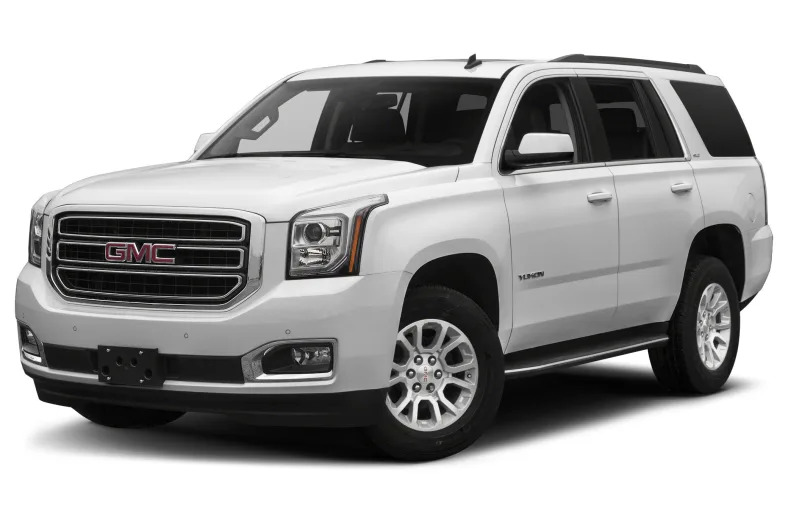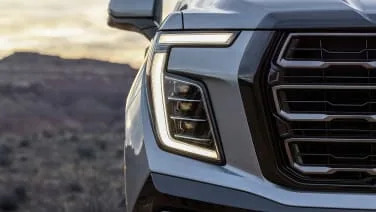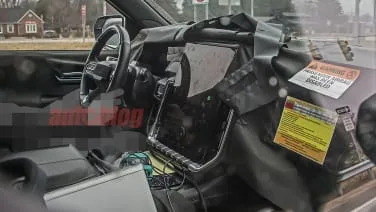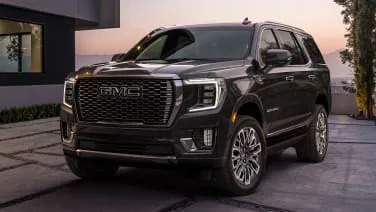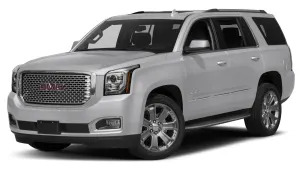2016 GMC Yukon
The GMC Yukon is a big seven-seat SUV with V8 power, essentially the GMC version of the Chevy Tahoe though with some significant differences in equipment. The GMC Yukon XL is the Suburban-size version, with a wheelbase of 130 inches, giving more legroom in the third row and cargo space behind it.
Built on truck chassis, these vehicles are among the few full-sized SUVs built body-on-frame, as opposed to being a unibody crossover with a car chassis. So the Yukon, like the land it was named for, is all about ruggedness, towing capability and hauling ability.
The standard Yukon engine is the 5.3-liter V8 making 355 horsepower and 383 pound-feet of torque, with a 6-speed automatic; but GMC also offers a 6.2-liter V8 making 420 hp and 460 lb-ft of torque.
So if you want the most towing capability, Yukon is the way to go. It's rated at 8500 pounds, although that's still not as much as the Ford Expedition's 9200 pounds, on the back of is twin-turbo 3.5-liter EcoBoost V6. It's also less than the Nissan Armada's 8200-9000 pounds, but more than the Toyota Sequoia or Dodge Durango.
Both Yukon engines are direct injected, which improves response and efficiency with precise fuel metering; and both use cylinder deactivation, which cuts the engine down to a V4 when the throttle is reduced. It's indicated on the instrument panel, but the driver never feels the transition. Fuel mileage with the 5.3-liter is EPA-rated at 16 mpg city, 23 mpg highway, and 18 mpg combined.
The ladder-type boxed frame uses mostly high-strength steel, for safety and rigidity. The rear suspension is old school, with a live axle and leaf springs, delivering a very good ride. But Magnetic Ride Control is available, the high-tech active suspension that basically absorbs bumps that the solid axle just deflects. A locking rear differential is standard.
Because the Yukon was redesigned for 2015, there's nothing new for the 2016 model year, except a capless fuel filler. However, there are enhancements to packages, such as the addition of Apple Car Play to the infotainment system.
Safety equipment standard on all models are a rearview camera and proximity sensors in front and rear, and with models having a bench seat in front, there's an additional airbag that separates the two passengers. Optional safety equipment includes adaptive cruise control, lane-departure warning, blind-spot monitoring, rear cross-traffic warning, and forward collision alert.
Rear-wheel drive is standard, four-wheel drive available. Yukon 4WD models use a single-speed Autotrac system for automatic operation on the highway. If you want 4WD with a low-range for rock crawling or slimy boat ramps, you have to get the HD tow package two-speed transfer case. Denali 4WD comes with it.
Full Review
Full Review
The GMC Yukon XL is the Suburban-size version, with a wheelbase of 130 inches, giving more legroom in the third row and cargo space behind it.
Built on truck chassis, these vehicles are among the few full-sized SUVs built body-on-frame, as opposed to being a unibody crossover with a car chassis. So the Yukon, like the land it was named for, is all about ruggedness, towing capability and hauling ability.
The standard Yukon engine is the 5.3-liter V8 making 355 horsepower and 383 pound-feet of torque, with a 6-speed automatic; but GMC also offers a 6.2-liter V8 making 420 hp and 460 lb-ft of torque.
So if you want the most towing capability, Yukon is the way to go. It's rated at 8500 pounds, although that's still not as much as the Ford Expedition's 9200 pounds, on the back of is twin-turbo 3.5-liter EcoBoost V6. It's also less than the Nissan Armada's 8200-9000 pounds, but more than the Toyota Sequoia or Dodge Durango.
Both Yukon engines are direct injected, which improves response and efficiency with precise fuel metering; and both use cylinder deactivation, which cuts the engine down to a V4 when the throttle is reduced. It's indicated on the instrument panel, but the driver never feels the transition. Fuel mileage with the 5.3-liter is EPA-rated at 16 mpg city, 23 mpg highway, and 18 mpg combined.
The ladder-type boxed frame uses mostly high-strength steel, for safety and rigidity. The rear suspension is old school, with a live axle and leaf springs, delivering a very good ride. But Magnetic Ride Control is available, the high-tech active suspension that basically absorbs bumps that the solid axle just deflects. A locking rear differential is standard.
Because the Yukon was redesigned for 2015, there's nothing new for the 2016 model year, except a capless fuel filler. However, there are enhancements to packages, such as the addition of Apple Car Play to the infotainment system.
Safety equipment standard on all models are a rearview camera and proximity sensors in front and rear, and with models having a bench seat in front, there's an additional airbag that separates the two passengers. Optional safety equipment includes adaptive cruise control, lane-departure warning, blind-spot monitoring, rear cross-traffic warning, and forward collision alert.
Rear-wheel drive is standard, four-wheel drive available. Yukon 4WD models use a single-speed Autotrac system for automatic operation on the highway. If you want 4WD with a low-range for rock crawling or slimy boat ramps, you have to get the HD tow package two-speed transfer case. Denali 4WD comes with it.
Hide Full Review
Retail Price
| Engine | 5.3L V-8, 6.2L V-8 |
| MPG | Up to 16 city / 23 highway |
| Seating | 8 Passengers |
| Transmission | 6-spd auto w/OD, 8-spd auto w/OD |
| Power | 355 - 420 hp |
| Drivetrain | four-wheel, rear-wheel |
| Curb Weight | 5,379 - 5,626 lbs |

